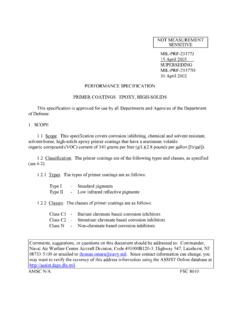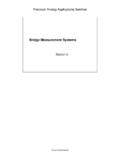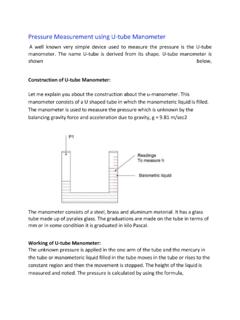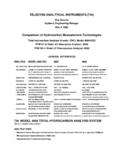Transcription of Determination of ILS Critical and Sensitive Areas: A ...
1 Determination of ILS Critical and Sensitive Areas: A Comparison of flight measurement versus simulation TechniquesS. Dale Courtney Senior Navigation Engineer US FAA, Air Traffic Organization Washington, DC, USA Voice: +1 202 493 5172 E-mail: ABSTRACT The quality of the Instrument Landing System (ILS) signal-in-space can be degraded by reflectors or sources of multipath. Static multipath is produced by signal reflection from fixed objects such as aircraft hangers or fencing on the aerodrome. Dynamic multipath is produced by signal reflection from moveable objects such as aircraft taxing around the runway environment. ILS Critical and Sensitive areas are implemented around Localizer and Glide Path facilities to protect aircraft on approach from dynamic multipath that could cause the ILS signal-in-space to exceed allowable tolerances for alignment and roughness.
2 Aircraft operation in Critical and Sensitive areas are either prohibited or operationally controlled. ILS Critical and Sensitive area sizes have been determined by both flight measurements, while aircraft are staged around the aerodrome, and more recently by computer simulation and modeling. The Navigation Systems Panel of the International Civil Aviation Organization (ICAO) is currently producing guidance material on the size of these areas given today s larger aircraft. This paper will compare flight measurement versus computer simulation techniques in determining Critical and Sensitive area sizes. This paper will also present Critical and Sensitive area size recommendations determined by work of the ICAO Navigation Systems Panel. INTRODUCTION Reflecting objects within the ILS radiated signal coverage volume, whether fixed objects or vehicles, can cause degradation of the signals-in-space beyond applicable tolerances, through signal blockage and/or multipath interference.
3 The amount of degradation is a function of the location, size, and orientation of the reflecting surfaces, and the ILS antenna characteristics. It is convenient to consider disturbances caused by aircraft and vehicles separately from disturbances caused by fixed objects such as buildings and terrain. The analysis of disturbances caused by aircraft and vehicles to the ILS signal-in-space performance results in necessary areas of protection around the localizer and glide path facilities referred to as Critical and Sensitive areas. Dimensions of Critical and Sensitive areas have historically been determined by direct flight measurement as well as varying levels of mathematical modeling. In direct flight measurement , a reflector such as an airplane is positioned in an area of concern and the resulting disturbance on the ILS signal-in-space is measured with a flight inspection aircraft.
4 Mathematical modeling predicts the amount of disturbance on the ILS signal-in-space due to reflectors using techniques from simple ray tracing to complex simulations made possible with computer models. Once necessary dimensions for Critical and Sensitive areas are determined about localizer and glide path facilities, the areas can be restricted or operationally managed so that aircraft or vehicles do not cause out of tolerance course and alignment changes and structure roughness to aircraft conducting an ILS approach. The International Civil Aviation Organization (ICAO) recognizes the importance of Critical and Sensitive areas on ILS operations and publishes dimensions of these areas in Attachment C, Information and Material for Guidance in the Application of the Standards and Recommended Practices for ILS, VOR, PAR, 75 MHz Marker Beacons (En-Route), NDB and DME to Annex 10, Volume 1, Standards and Recommended Practices for Aeronautical Telecommunications, Radio Navigation Aids.
5 BACKGROUND AND DEFINITIONS ICAO s Navigation Systems Panel recognized the importance to consider the completeness of the current material on Critical and Sensitive areas considering introduction of larger aircraft such as the Airbus A380. In March 2007, the Navigation Systems Panel commissioned an Ad-Hoc group to consider updates of ILS guidance material in the area of Critical and Sensitive area sizes necessary to assure integrity of ILS operations. The Ad-Hoc group s work was completed and accepted by the panel in April 2008. The Ad-Hoc group first aligned the definitions of Critical and Sensitive areas to be consistent and more flexible with how ILS operations are managed in the operational environment. The new definitions are: Critical Area: The ILS Critical area is an area of defined dimensions about the localizer or glide path antenna, such that aircraft and other vehicles within the area cause out-of-tolerance disturbances to the ILS signals-in-space from the limit of the coverage to a distance of km (2NM) from the landing threshold.
6 Sensitive Area: The ILS Sensitive area is an area of defined dimensions about the localizer or glide path antenna, such that aircraft and other vehicles within the area cause out-of-tolerance disturbances to the ILS signals-in-space from a distance of km (2NM) from the landing threshold to the point at which the ILS signal is no longer required for the intended operation. Next, the Ad-Hoc group defined the criteria used to determine the dimensions of Critical and Sensitive areas. The group understands total distortion is the combination of fixed and mobile sources. The group recognizes that the root sum square (RSS) combination of the disturbances due to fixed and mobile objects gives a statistically valid representation of the total disturbance as compared to that of an algebraic sum.
7 For example, a limit of plus or minus 5 A for localizer course structure would be respected with plus or minus 3 A of disturbance due to fixed objects and an allowance of plus or minus 4 A for mobile objects: AAA 54322=+ Fixed sources are considered to consume 60% of allowable signal-in-space tolerance leaving 80% of allowable tolerance to be consumed by mobile sources. Critical and Sensitive area Determination is then based on distortion from mobile objects consuming 80% or more of allowable tolerance, considering an RSS model. Finally, the group determined Critical and Sensitive area dimensions using simulations from complex computer mathematical models. The mathematical models used were well validated by direct comparison with ground and flight measurements for a variety of specific situations and environments.
8 COMPARISON OF flight measurement versus simulation Critical and Sensitive areas were developed for several configurations of localizer and glide path antenna types matrixed with aircraft representing four different aircraft height groups. One quickly sees that using the direct flight measurement technique of evaluating different aircraft positioned in various locations around the aerodrome becomes both time and cost prohibitive. Further analysis reveals aircraft positioning and orientation can be Critical in determining an out of tolerance distortion. Mathematical model simulations can determine distortion produced from many positions and orientations of aircraft with a much smaller investment of time and resources when compared to direct flight measurement .
9 Several European Air Navigation Service Providers (ANSP) recently completed a series of tests to validate mathematical models with direct flight measurement . These tests were conducted at the Frankfurt, Toulouse, and Heathrow aerodromes. Locations of interest were determined using mathematical simulation . Boeing B747 and Airbus A380 aircraft were positioned as determined in the simulation and then ground and flight measurements were made of the resulting ILS distortion. Similar tests were conducted in the United States at the Dallas-Ft. Worth aerodrome in 1982. These tests were used to validate mathematical simulation models. Samples of the validation work conducted at the Dallas-Ft. Worth aerodrome are presented in Figures 1 and 2.
10 Figure 1. Localizer Approach with B747 Positioned 1000 Feet from Array and Center of Aircraft 250 Feet Off Centerline with Tail Toward Centerline Figure 2. Glide Path Approach with B747 Positioned 448 Feet from Threshold and 376 Feet from Centerline simulation RESULTS The simulation results presented illustrate aircraft positions (colored points) that cause distortion to the ILS signal-in-space and consume 80% or more of the allowable tolerance. simulation results presented first show the reduction in Critical area sizes when choosing larger aperture localizer arrays. The aircraft chosen for this comparison is the Boeing 747. Figure 3. Critical Area simulation of B747 with Small Aperture Localizer Array Figure 4. Critical Area simulation of B747 with Medium Aperture Localizer Array Figure 5.







